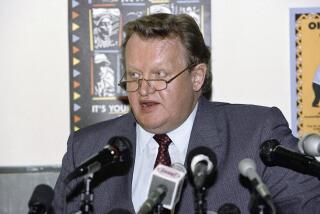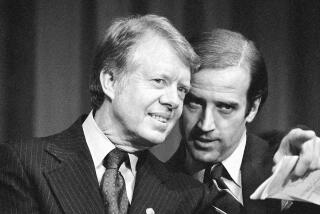Helsinki Has Been Stage for Process of Global Cooperation : Detente: But postwar efforts to narrow East-West gaps on security and human rights have seen controversy.
- Share via
HELSINKI, Finland — Moments after touchdown here Saturday, President Bush paid tribute to the exceptional role this locale has already played in reshaping the postwar world.
“The city of Helsinki has often been a meeting place for nations seeking to advance the cause of peace,” Bush said after stepping off Air Force One. He expressed hope that his talks with Soviet leader Mikhail S. Gorbachev here will help lay “the cornerstone” of a safer world order.
Despite Bush’s gracious plaudits, not long ago Finland’s capital was mentioned by some Western politicians as a place where democracies had sold out or folded in the face of tyranny. For their part, Soviet leaders reacted with brutality to their citizens who dared invoke the human rights commitments their country had solemnly made here.
Fifteen years ago, on Aug. 1, 1975, the heads of state or government of 35 nations, including President Gerald R. Ford and Soviet General Secretary Leonid I. Brezhnev for the superpowers, came together in Helsinki’s Finlandia Hall--the same white marble edifice where Bush and Gorbachev will hold a news conference today--to sign the Final Act of the Conference on Security and Cooperation in Europe.
What was known in diplomatic shorthand as the “Helsinki conference” had largely been the Kremlin’s brainchild.
“The purpose (of the Helsinki conference) was to legitimize the territorial and political changes brought about by the war: the fruits of the Soviet victory,” said veteran Finnish diplomat and political observer Max Jakobson.
At Helsinki, as during more than 1 1/2 years of preparatory talks in Geneva, the United States, Canada and their European allies were asked to ratify a kind of Kremlin hybrid of the Monroe Doctrine, including a pledge not to interfere in the internal affairs of other states, meaning, in effect, Moscow’s six Warsaw Pact satellites. The Helsinki document would also ratify all post-World War II frontiers--among them, the territorial gains made by Josef Stalin’s armed forces.
The West’s assent to such a proposal would increase stability in Europe by, for example, burying hopes for change in the borders of regimes of Eastern Europe, in the official Soviet view at the time.
But NATO member states, and some neutral countries like Sweden, insisted that the Helsinki document not only protect the prerogatives of governments, but also the rights of their citizens.
“The participating states will respect human rights and fundamental freedoms, including the freedom of thought, conscience, religion or belief, for all without distinction as to race, sex, language or religion,” was the wording finally accepted in the 35-nation accord, including by such hard-line regimes as Erich Honecker’s East Germany, Nicolae Ceausescu’s Romania and Brezhnev’s Soviet Union.
In consequence, when the Kremlin leader raised his glass to President Ford to toast the signature of the Helsinki Final Act, many in the West grieved. In the eyes of Ronald Reagan, who the following year was to unsuccessfully challenge Ford for the Republican presidential nomination, Ford and Secretary of State Henry A. Kissinger had sold out the Poles, the Czechoslovaks, the Hungarians and the other peoples of Eastern Europe by accepting the status quo there in exchange for meaningless Kremlin guarantees on human rights.
Behind what was still the Iron Curtain, however, the solemn rights pledges made in Helsinki gave rise to great hopes. Courageous people like Andrei D. Sakharov demanded that the commitments made in Finlandia Hall be kept, and in the East Bloc, non-sanctioned “Helsinki Watch groups” were launched by human rights activists to monitor their governments’ compliance.
The Finns, who originally broached the idea of an all-European security conference as early as 1969, perhaps as an outgrowth of Soviet prompting, were by all accounts surprised by the twist many gave the Helsinki Final Act. The Finns had intended the conference to defuse Cold War tensions in Europe, rather than inspire people in the East to become more like those in the West.
“Originally, the Helsinki Final Act could be interpreted as a recognition of the Soviets’ hegemony in their sphere of influence, or with emphasis on the human rights clauses,” said a Swedish diplomat and specialist in diplomatic history, who asked not to be identified. “The Finns in 1975 would certainly have stressed the first interpretation, feeling that recognition of Soviet interests was the best route for fostering detente.”
The Helsinki conference was a triumph for Finland’s president at the time, Urho Kekkonen, who had managed to assemble the leaders of the superpowers and all European countries except Albania at a forum that consecrated Finland’s position as a neutral intermediary between the blocs.
With the ascent of Jimmy Carter to the U.S. presidency in 1976, American policy began to hit the human rights theme much harder. But it was undoubtedly Gorbachev’s elevation to the Soviet leadership a decade after the Helsinki conference that went the furthest toward translating the ideals once voiced here into reality for much of Europe.
“There is now a code of behavior approved by all 35 countries, and there is also a system of review to see how it is being adhered to,” Aarno Karhilo, undersecretary of state for political affairs at the Finnish Ministry for Foreign Affairs, said in an interview.
Even Gorbachev’s most hostile critics admit he has done much to bring a society that once imprisoned dissidents or banished them to mental institutions into line with the Helsinki human rights provisions. Just as important, he’s allowed the nations of Eastern Europe to go their separate ways, basically renouncing the geopolitical gains the Kremlin made here 15 years ago.
What those who met in Finlandia Hall then seemed to have foreseen was that they were beginning a process--rapidly nicknamed the “Helsinki process” or the “CSCE process,” from the 1975 treaty’s full name--that was to vastly increase cooperation and security in Europe and make the concept of a “common European home” seem within reach.
During the last visit by a U.S. President here, Reagan in 1988 showed the change in his thinking by hailing the Helsinki Final Act as evidence of “an increasing realization that security and human rights must be advanced together or truly cannot be secured at all.”
“Now that Moscow has acknowledged the need for economic and social change, Helsinki sends a new message,” Jakobson has written. “It no longer stands primarily for the status quo but for change, in Eastern Europe and the Soviet Union itself.”
Helsinki Diplomacy 1975 Conference on Security and Cooperation in Europe 35 nations gather to discuss reducing arms, relieving tensions and promoting security. Landmark accords codify human rights standards. Ford-Brezhnev summit President Gerald R. Ford and Soviet President Leonid I. Brezhnev meet for three days during international conference. 1982-1985 Three successive Soviet leaders visit Yuri V. Andropov, Konstantin U. Chemenko and Mikhail S. Gorbachev each pay calls on Finnish President Mauno Koivisto early in their terms. 1988-1989 Reagan, Gorbachev praise Finnish diplomacy President Ronald Reagan visits in May, 1988, on his way to Moscow, Gorbachev in Octobert, 1989. Each lauds Finland’s role in bridging the East and West. 1990 Bush-Gorbachev summit President Bush and Gorbahev choose Helsinki as site of first of their short-notice summits, with the Persian Gulf crisis topping the fexible agenda.
More to Read
Sign up for Essential California
The most important California stories and recommendations in your inbox every morning.
You may occasionally receive promotional content from the Los Angeles Times.












